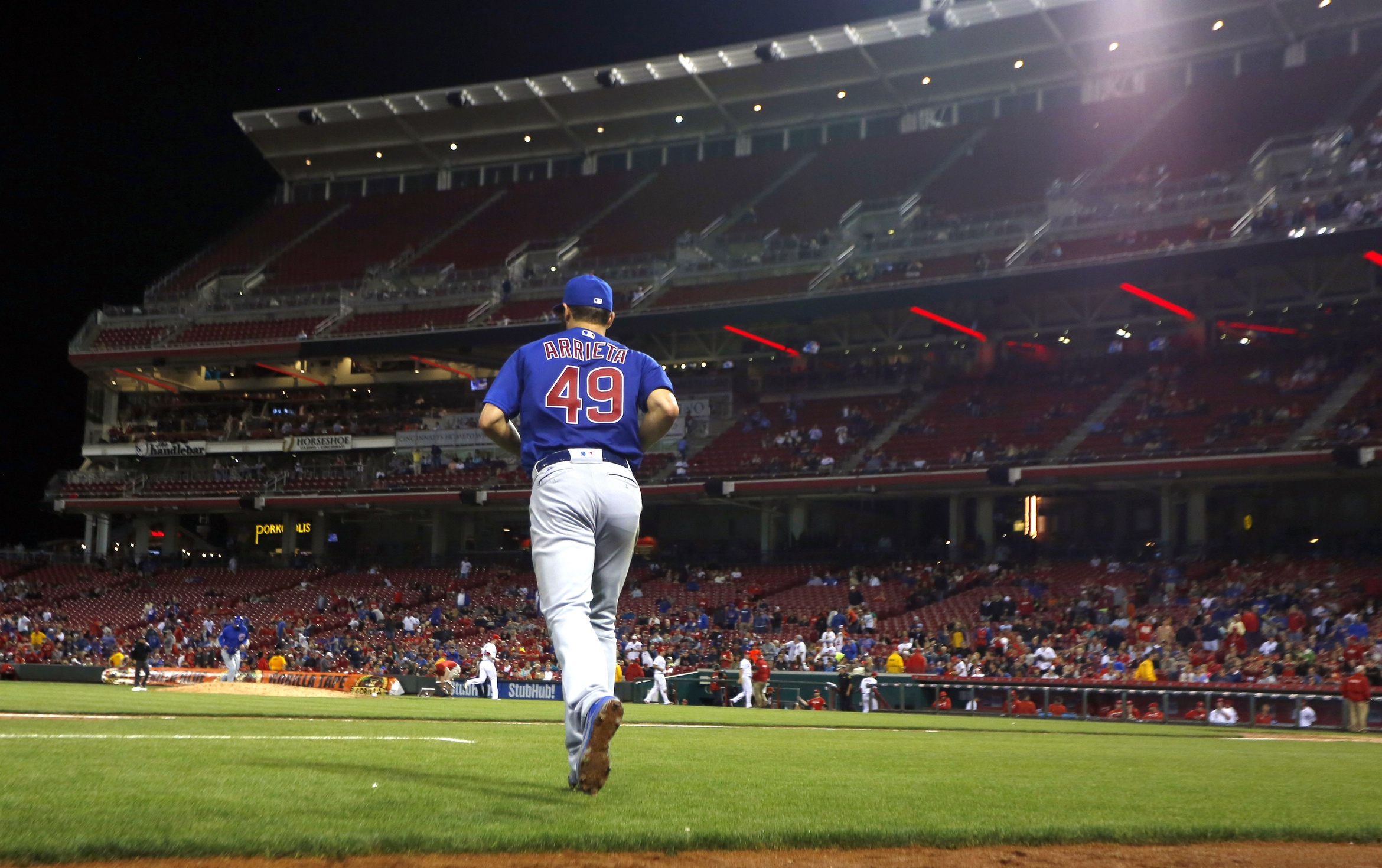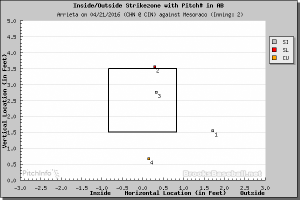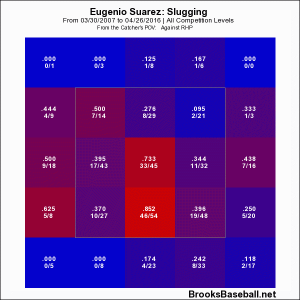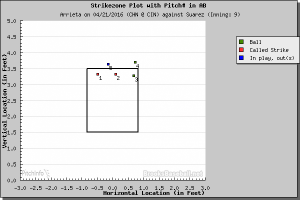Introduction
“We’re getting the band back together.”
“You’re kidding. No way.”
“We’re on a mission from God.”
— Jake Blues, Mr. Fabulous, Elwood Blues
We’re back. The Ballad is back, even if just for one night. And while it did not take divine intervention, it required a feat of historic proportions: Jake Arrieta becoming the 30th picture in major league history to pitch two caeer no-hitters.
Now, admittedly, I am no Jake or Elwood. If anything, I probably fall closer to whatever Blues Brother Jim Belushi or John Goodman portrayed. However, that doesn’t mean we still can’t sell out the Palace Hotel Ballroom, or in this case, keep you entertained and informed over the next 1,700 words.
On Thursday against the Cincinnati Reds, Arrieta continued as dominant a stretch as we’ve ever witnessed. He made it clear from the outset that he was not messing around against the Reds. Arrieta went to the sinker—his go-to pitch (see below)—25 of 29 first pitches, with 17 going for strikes (seven whiffs). Of the 29 first pitches, 20 were strikes. As you will see in the Pitch Breakdown section, Arrieta mixed his slider and curve, but they were clearly secondary pitches. After throwing 49 pitches in the first three innings, Arrieta grew more efficient as the game progressed, needing just 18 pitches combined to get through the seventh and eighth innings, and 34 over the final three frames.
Of course, the early returns on the 2016 Cincinnati Reds are they are a decidedly mediocre offense. The Reds rank in the middle-of-the-pack in nearly every offensive category, including runs scored, slugging percentage, home runs, doubles, ISO, and home run to fly ball ratio. In fact, the true irony of the night is that they were able to draw four walks, as they entered the night ranked second-to-last in the NL in walk rate. And, if we’re picking the tiniest of nits, it would be concerning Arrieta’s control. His historic performance came on a night in which he was not his sharpest, command-wise. In fact, the broadcast team made repeated mention of Arrieta missing spots. The four walks were his highest single game total since last June 16 at the Cleveland Indians. His 59 percent strike rate was his worst mark since August 4 at Pittsburgh. Arrieta was still outstanding, obviously, but the ball was staying up on him more than we’re accustomed to seeing.
Nevertheless, Arrieta made history on the banks of the Ohio River. Scroll a few inches lower to learn how it all went down.
Traditional Line
9.0 IP, 0 H, 6 K, 4 BB, 0 ER
Pitch Breakdown
119 pitches (71 strikes)
| Pitch | Total | Velocity (Max) | AVG | SLG | BABIP |
| Sinker | 79 | 95.0 (97.2) | .000 | .000 | .000 |
| Change | 3 | 88.8 (90.3) | .000 | .000 | .000 |
| Slider | 23 | 89.1 (90.9) | .000 | .000 | .000 |
| Curve | 14 | 81.7 (83.8) | .000 | .000 | .000 |
As we discussed in the introduction, Arrieta was sinker-happy on Thursday night. His 79 sinkers throw was the highest single game total of his career. Arrieta went to the sinker on 85 percent of first pitches and 51 percent of two-strike counts, more than 13 percent above his season average. Of the nine three-ball counts, he went to the sinker in six of them, after having done so just five times in his first three starts. In short, he continued to favor his sinker. You get the idea.
Arrieta did pick up two strikeouts with the curve, which he had working in harmony with his sinker. Of his 31 two-strike pitches, eight were curves, the second most of any pitch after his sinker. Since that represents more than half of the curves he throw on the night, it’s clear Arrieta and Ross were using it to complement the fastball. Arrieta’s second inning strikeout of Devin Mesoraco came on a curve in the dirt after two sinkers and a slider up in the zone:
Arrieta did not have his sharpest slider in this game, but he mixed it in well. Of the 28 second pitches, seven were sliders, and all came after his sinker. He has thrown it with the second most frequency of any pitch this season (24 percent), and he has yet to surrender a hit. For the second time in four 2016 starts, he threw zero four-seam fastballs, after doing it just three times in all of 2015.
Trends
WARNING: Some number dumps will put you to sleep and serve only as a crutch for lazy writers. While the latter may still apply below, I promise you this is one number dump that will blow your damn minds.
There’s having a good feel for a pitch, and there’s what Arrieta has done with his sinker over the last 10 calendar months. From the start of 2014 through his start against the Cleveland Indians last June 14, a span of 38 starts, he had thrown sinkers for 32 percent of all pitches.
That start preceded the sinker frenzy, which began with his June 21 start against the Minnesota Twins, and his continued for the past 24 consecutive regular season starts. Since that day in Minnesota, Arrieta has thrown his sinker for 48 percent of all pitches (67 percent against right-handed batters). That number jumped to 52 percent in his four playoff starts, and 62 percent in 2016. Including the postseason, batters are slugging .216 against the pitch, and he has not surrendered a home run. In fact, he’s surrendered just 13 extra-base hits (all doubles) with the pitch, which is astonishing considering he’s thrown 1,300 in the 28 starts. That means 1 out of every 100 sinkers he’s thrown has gone for an extra-base hit. At this point it has become the baseball equivalent of “Why don’t they build the whole plane out of the Black Box?”
Through four starts this season, Arrieta has increased his sinker usage by 20 percentage points from 2015, mostly coming at the expense of his fourseam and curve. One of 2016’s most intriguing subplots will be whether Arrieta can and will continue to rely so heavily on his primary pitch.
Key At-Bat/Sequence
Inning: Bottom of the ninth
Score: 16-0, Cubs
Situation: Scott Schebler on first base, two outs
Batter(s): Eugenio Suarez
Last season, across 32 Jon Lester Ballads, we made frequent mention of David Ross’s pitch calling abilities. Even when Lester struggled, especially with home runs off cutters in the middle of the season, it was often due to execution, as opposed to game plan. Batters’ weaknesses were exploited and their strengths were neutralized or avoided. That same kind of preparation was on full display with the super ticket of Arrieta-Ross.
In Suarez’s first at-bat, Arrieta started Suarez with a slider, which he took for strike one, and a curve in the dirt, on which he whiffed for strike two. So, why make Suarez one of the Reds four batters on the night not to get a first pitch sinker? Entering the game, against right-handed pitchers, Suarez was slugging .167 against sinkers and was hitless against curves. After Suarez took a pair of 96 MPH sinkers away to even the count at 2-2, Arrieta came back over the half of the plate with sinker that produced a groundout. All five pitches were middle of the plate away.
By Suarez’s second at-bat, a clear pattern had developed. Arrieta and Ross went away with five sinkers and a slider. Of the six pitches, only a second pitch sinker, which Suarez fouled off, came near the middle of the plate. He eventually worked a walk, but they had stuck to their script of staying away from Suarez.
It might just have been one batter with less than 800 career plate appearances, in one game of a long season, but it encapsulates perfectly a pitcher and his catcher dialed in. Suarez owns just a career .398 slugging percentage against right-handed pitchers, but he’s fared exceptionally well against right handers when they come middle and inside:
Arrieta and Ross knew his strength and game planned accordingly.
Suarez’s next at-bat saw him take a 95 MPH sinker that ran back inside for strike one. On 0-1, Arrieta induced a groundout on a 95 MPH sinker that stayed on the outer half of the plate.
By the time Suarez stepped to the plate in the ninth, he had seen 12 pitches from Arrieta, nine of which had been sinkers, and 11 of which had been middle or away. By this point, Arrieta had thrown 114 pitches, and the fatigue was beginning to show. The pitches—four sinkers and a curve—all missed their spots, and stayed up in the zone:
Arrieta and Ross continued to attempt to away from Suarez, but the ball drifted back across the plate. The game’s final pitch was a 95 MPH sinker on 2-2 that again stayed way up in the zone. Suarez, however, could muster only a harmless fly ball to right field. Mere moments after the ball dropped into Jason Heyward’s glove, the dog pile in front of the pitcher’s mound had commenced.
Keep-In-Mind
Not to be that guy, but Arrieta was facing an adequate-at-best Reds offense.
(I’m just kidding. Could you imagine being that guy?)
No, for this KIM (c) section, we just wanted to point out that amazingly, by Game Score (89), this was just Arrieta’s fourth best outing since the start of 2014. His complete game shutout of the Milwaukee Brewers last September 22 (3 hits, 1 walk, 11 K’s) was a 91. Going back to 2014, Arrieta posted a 97 in a complete game shutout of the Reds on September 16 (1 hit, 1 walk, 13 K’s). Last August’s no-hitter against the Los Angeles Dodgers was a 98. On that fateful Sunday evening in Chavez Ravine, he struck out 12 and issued just one free pass. You know a pitcher is in a special groove when you can say, “This wasn’t even the best no hitter he’s thrown the past couple of seasons.”
Conclusion
We can debate endlessly across columns, podcasts, Twitter back and forths, and AIM Instant Messenger conversations (That’s right, I’m still there. A-I-M ’til I D-I-E) who is the best pitcher in baseball, but after Thursday night, it’s clear nobody is pitching better than Jake Arrieta. In what has come to define his unprecedent stretch of success, Arrieta went to his sinker early and often. The slider and curve were decent, and hung a bit too often in the later innnings, but they were good as complementary pitches. There were plenty of deep counts and missed locations, but the Reds could do little to take advantage
Thanks for joining me for the first Ballad of 2016. This season, we might not be Lester-specific or appear once or twice a week, but when a Cubs starting pitcher does something significant, we’ll be here with too many numbers, bad puns, and strained, dated pop cultural references.
Season-to-Date
4-0, 0.87 ERA (0.00 DRA), 0.68 WHIP, 24.1% K, 5.6% BB
Next Start
Wednesday, April 27 vs. Milwaukee Brewers
Lead photo courtesy David Kohl—USA Today Sports.



